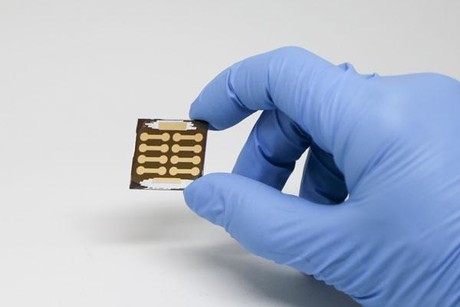Low-temperature manufacturing for low-cost solar cells

Researchers at the University of Toronto have cleared a critical manufacturing hurdle in the development of perovskite solar cells, in a breakthrough which could make printing solar cells as easy and inexpensive as printing a newspaper.
Today, most commercial solar cells are made from thin slices of crystalline silicon which must be processed to a very high purity. This energy-intensive process requires temperatures higher than 1000°C and large amounts of hazardous solvents.
In contrast, perovskite solar cells depend on a layer of tiny crystals — each about 1000 times smaller than the width of a human hair — made of low-cost, light-sensitive materials. Because the perovskite raw materials can be mixed into a liquid to form a kind of ‘solar ink’, they could be printed onto glass, plastic or other materials using a simple inkjet process.
However, in order to generate electricity, electrons excited by solar energy must be extracted from the crystals so they can flow through a circuit. That extraction happens in the electron-selective layer (ESL). The difficulty of manufacturing a good ESL has been one of the key challenges holding back the development of perovskite solar cell devices.
“The most effective materials for making ESLs start as a powder and have to be baked at high temperatures, above 500°C,” said Dr Hairen Tan. “You can’t put that on top of a sheet of flexible plastic or on a fully fabricated silicon cell — it will just melt.”
Writing in the journal Science, Tan and his colleagues described a new chemical reaction that enables them to grow an ESL made of nanoparticles in solution, directly on top of the electrode. While heat is still required, the process always stays below 150°C — much lower than the melting point of many plastics. The nanoparticles are then coated with a layer of chlorine atoms, which helps them bind to the perovskite layer on top and thus allows for efficient extraction of electrons.
Solar cells manufactured using the new method had an efficiency of 20.1% — the best ever reported for low-temperature processing techniques, according to Tan, and only 2% lower than the efficiency of perovskite solar cells processed using the high-temperature method. Additionally, while many perovskite solar cells experience a severe drop in performance after only a few hours, Tan’s retained more than 90% of their efficiency after 500 hours of use.
The low-temperature manufacturing process opens up a range of applications for perovskite solar cells, from smartphone covers that provide charging capabilities to solar-active tinted windows that offset building energy use. In the nearer term, Tan believes his technology could be used in tandem with conventional solar cells.
“With our low-temperature process, we could coat our perovskite cells directly on top of silicon without damaging the underlying material,” he said. “If a hybrid perovskite-silicon cell can push the efficiency up to 30% or higher, it makes solar power a much better economic proposition.”
Key factors to consider with fire protection for an EV battery
This article explores some factors for EV battery designers to consider when deciding on...
Researchers claim record PV efficiency for kesterite solar cell
UNSW researchers have reportedly set a new record for a kesterite solar cell, which could be a...
Sodium-ion study says tech needs breakthroughs to compete
A new study from Stanford has found that sodium-ion batteries will need more breakthroughs in...




